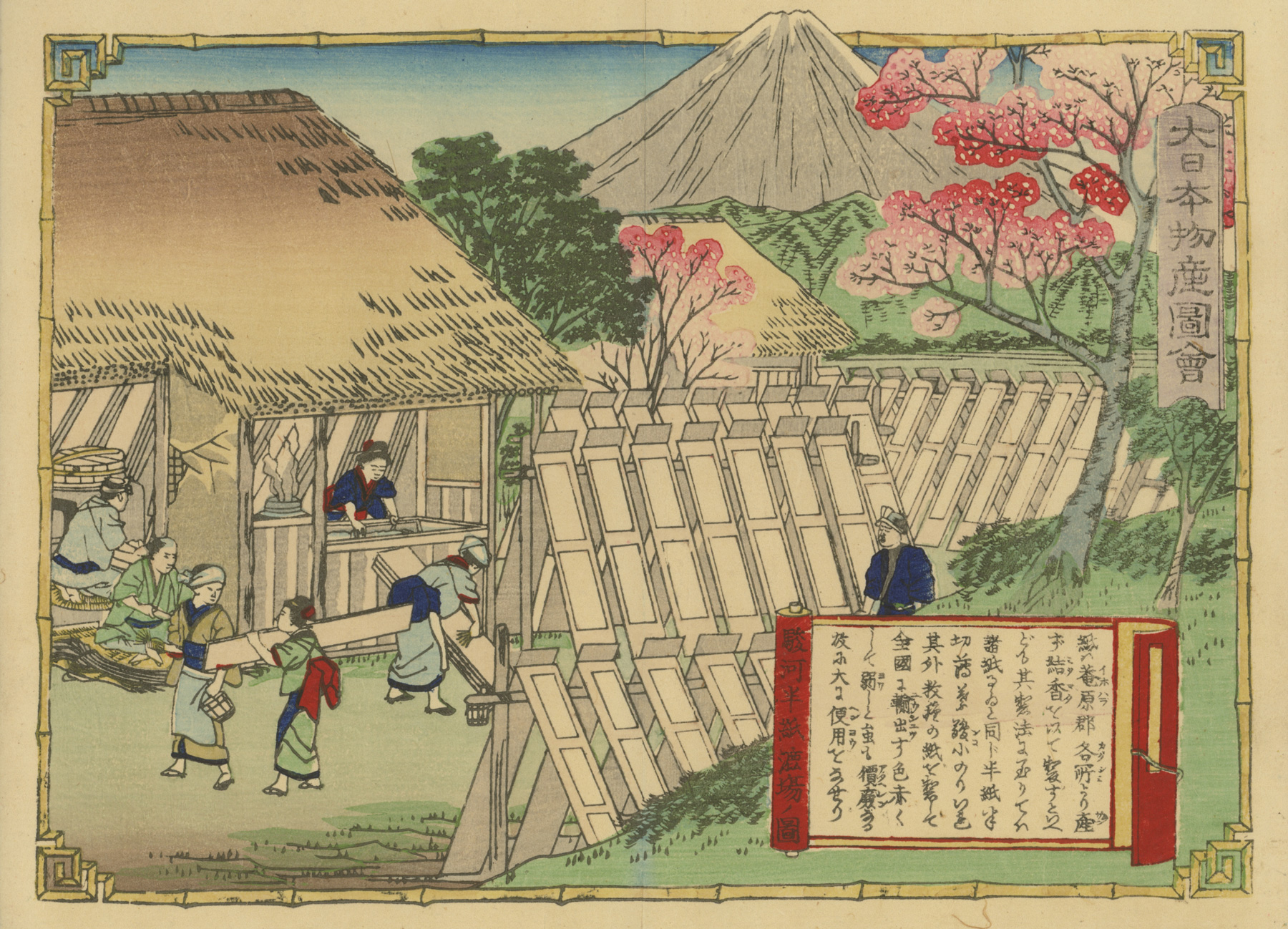About This Print
One of 118 prints in the series Dai Nippon Bussan Zue (Products of Greater Japan), issued in August 1877 to coincide with the opening of Japan’s first National Industrial Exposition (Naikoku Kangyō Hakurankai) held in Tokyo’s Ueno Park, depicting the manufacture of hanshi, a fine washi.
An 1871 Account of Making Hanshi delivered to the House of Commons
Source: Parliamentary Papers (Great Britain, Parliament, House of Commons): Accounts and Papers, Volume 67, Reports on the Manufacture of Paper in Japan, Sir H. Parkes, p. 5, Harrison and Sons, 1871
| Making the Paper called “Hanshi” The bucket contains warm water in which to dip the hands when cold. The box or frame used in making “sughara” (a large size of paper) is very heavy, so that men are employed in the manufacture of the latter; but women can manipulate the frames used for “hanshi.” The “sosori” to be used is made into a large ball, from which lumps are broken off as required. These lumps are cast into what is called the “boat,” and thoroughly mixed with sell-strained “tororo” paste. It should be stirred thoroughly, and is of proper consistency when the stick makes a slight noise when passing through the pulp. If not sufficiently sticky, more “tororo” should be added, but the proportion of the ingredients can only be learned by practice. The pulp should not cling to or wind round the stick, but should be thoroughly stirred and well mixed. The “boat:” length 6 feet; breadth 3 feet, with a perpendicular rest for leaning the frame against it. The false bottom is placed in the outer frame, into which a portion of the pulp is then poured. The inner frame is then fitted in to keep the false bottom steady, and a peculiar and dexterous jerk is given to the whole, which sets the paper. The frame is then leaned against the upright rest to allow the water to drain off, while another frame is prepared. By the time the second frame is ready the first may be removed. This manipulation can be performed very quickly by experts in the manufacture. Drying the Paper The sheet of paper is removed from the frame with a piece of bamboo…by dexterously curling the thicker end of the paper round it; the brush is taken in the right hand, and with it the paper is laid on the drying-board, … the side which adheres to the board being the face of the paper. Five sheets are placed on each side of the board, which is 6 feet long. In fine weather the paper dries quickly, and in wet weather it is sometimes dried by the heat of a fire. Each manipulator requires forty drying boards. Cutting “Hanshi” into Proper Sizes Between every 20 sheets two or three straws are inserted. The paper, in parcels of 100 sheets, is then placed upon a table, and a heavy ruler put on the top of it, which is kept steady with the right foot. The paper is held in the left hand, and cut off with a knife… It is then packed,… and is finally made up into bundles ready for the market. |
Scroll Inscription
Source: National Museum of Japanese History http://www.rekihaku.ac.jp/up-cgi/getdocrd.pl?tn=1555&ti=0&h=./history/w11288752628_28652&ch=2&p=param/nisikie/db_param&o=1551&k=50&l=&sf=0&so=Notes:
[備考]中判 横 錦絵 画工:歌川広重3 安藤徳兵衛大鋸四番地 安藤徳兵衛 版元:大倉孫兵衛 日本橋通一丁目十九番地 主題内容:産業・技術 物産絵 駿河 庵原郡 人名その他:和紙 貼板 桜 富士山
Scroll:
「紙は庵原郡各所より産ず 結香を以て製すといへども其製法に至りては諸紙るゐと同じ 半紙半切薄葉駿小のりいれ其外数種の紙を製して全国に輸出す 色赤くして弱しと雖も価廉なる故に大に便用をなせり」
Multiple Editions (Variant Printings)
At least three variant printings (editions) were made of this series. Each variant printing uses a different colored cartouche containing the series' title, either red, green or rainbow-colored. Different colored borders were also used and variances in the use of colors and shading are present in the three editions.
Print Details
| IHL Catalog | #381 |
| Title or Description | Papermaking in Suruga Province 駿河半紙漉場ノ図 [駿河紙半紙漉場ノ図] |
| Series | Dai Nippon Bussan Zue 大日本物産図会 (Products of Greater Japan) |
| Artist | Utagawa Hiroshige III (1842–1894) |
| Signature | no signature |
| Seal | none |
| Publication Date | 1877 (Meiji 10) |
| Publisher | Ōkura Magobei 大倉孫兵衛 (Kin'eido; 1843-1921) [Marks: pub. ref. 627] |
| Impression | excellent |
| Colors | excellent |
| Condition | fair - separation along top of vertical centerfold; overall toning |
| Genre | nishiki-e; kaika-e |
| Miscellaneous | |
| Format | chuban |
| H x W Paper | 6 7/8 x 9 3/8 in. (17.5 x 23.8 cm) |
| H x W Image | 6 1/2 x 8 7/8 in. (16.5 x 22.5 cm) |
| Literature | |
| Collections This Print | NIJL Archives & Collections 37T / 029; National Museum of Japanese History H-22-1-30-7-31 |


